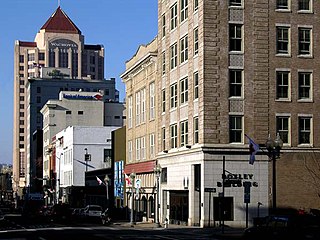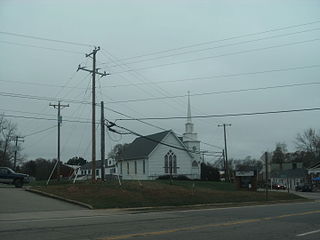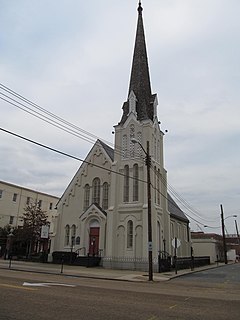
The Roanoke Downtown Historic District is a national historic district located in the Downtown Roanoke area of Roanoke, Virginia. It encompasses 122 contributing buildings. It includes a variety of commercial, institutional, social, and governmental buildings and structures from the late 19th century to the mid-20th century. Notable buildings include the Roanoke City Public Library, the YMCA Central Branch Building, First Christian Church (1925), the Central Church of the Brethren (1924), Tomnes Cawley Funeral Home (1928), Thomas B. Mason Building (1961), Peerless Candy Co., City Hall / Municipal Building (1915), Roanoke Times Building (1892), Anchor Building / Shenandoah Building (1910), Greene Memorial Methodist Church (1890), and United States Post Office and Courthouse (1930). Located in the district are the separately listed Patrick Henry Hotel, the Boxley Building, the Campbell Avenue Complex Historic District, Colonial National Bank, and First National Bank.

Farmville Historic District is a national historic district located at Farmville, Prince Edward County, Virginia. It encompasses 246 contributing buildings and 1 contributing object in the central business district and surrounding residential areas of Farmville. It includes a variety of commercial, residential, institutional, and industrial buildings dating from the mid-19th to early-20th centuries. Notable buildings include the Paulett-Gill house, Farmville Presbyterian Church, Johns Memorial Episcopal Church (1881), Farmville Methodist Church (1907), Hotel Weyanoke (1925), the warehouses of the Dunnington Tobacco Company and Central Virginia Processing, Inc., the former Craddock-Terry Shoe Company, the former Cunningham and Company tobacco prizery, Norfolk and Western Railroad passenger station, Doyne Building, the Watkins M. Abbitt Federal Building (1917), Prince Edward County Courthouse, and the former Farmville High School (1913). Located in the district is the separately listed First Baptist Church.

Cumberland Court House Historic District is a national historic district located at Cumberland, Cumberland County, Virginia. The district encompasses 111 contributing buildings, 5 contributing sites, and 8 contributing objects in the county seat of Cumberland County, Virginia. It includes the governmental core of the village and the residential, commercial, educational, and religious resources that have grown up around the courthouse since Cumberland's designation as the county seat in 1777. In addition to the separately listed Cumberland County Courthouse complex, notable buildings include Burleigh Hall, Woodlawn, Center Presbyterian Church (1852), Red Rose Inn, Stewart-Crockett House, All Saints Episcopal Church, Larkin Garrett House (1903), Flippen-Crawley House (1905), Joseph Carpenter House (1903), Masonic Lodge #283 (1903), and Payne Memorial United Methodist Church (1914).

Floyd Historic District is a national historic district located at Floyd, Floyd County, Virginia. It encompasses 164 contributing buildings, 1 contributing site, and 1 contributing object in the central business district and surrounding residential areas in the county seat of Floyd. They include residential commercial, institutional, and governmental buildings largely built between 1832 and 1955. Notable buildings include the Phlegar House (1816), Ferdinand A. Winston House, Henry Dillon House (1851), Floyd High School (1913), Horatio Howard Building (1897), Freezer Shirt Factory (1936), and Floyd County Courthouse (1951-1952). The district includes the separately listed Floyd Presbyterian Church and Glenanna.

Christiansburg Presbyterian Church is a historic Presbyterian church located at 107 W. Main Street in Christiansburg, Montgomery County, Virginia. The church was organized in 1827. The building was erected in 1853 and is a four bay long, brick church building with a low hipped roof. It features a three-stage tower consisting of a low, plain base, a square belfry with coupled Doric order corner pilasters, and a blind lantern stage. The whole is capped by an octagonal spire. Also on the property is the contributing former Rectory, now known as the Kinnard Smith Building and used as a parish house.

Berryville Historic District is a national historic district located at Berryville, Clarke County, Virginia. It encompasses 313 contributing buildings and 1 contributing object in the town of Berryville. They include a variety of residential, commercial, and industrial buildings dating from the late 18th century to the 1930s. Notable buildings include the Treadwell Smith House, Sarah Stribling House, Crow's Nest (1830s), Berryville Presbyterian Church, Grace Episcopal Church (1857), Coiner's Department Store, Clarke Milling Company, H. W. Baker Grain Warehouse, H. B. Whiting Brothers Warehouse, Berryville railroad depot (1910), the First National Bank, the Farmers and Merchants National Bank, and the U.S. Post Office (1938). The contributing object is the Clarke County Confederate Memorial on the grounds of the courthouse. Located in the district and separately listed is the Old Clarke County Courthouse.

Culpeper Historic District is a national historic district located at Culpeper, Culpeper County, Virginia. It encompasses 129 contributing buildings and 1 contributing object in the central business district of the town of Culpeper. Notable buildings include the Culpeper County Courthouse (1874), Municipal Building (1928), jail and sheriff's office (1908), the Ann Wingfield School (1929), St. Stephen's Episcopal Church (1821), Culpeper Presbyterian Church (1868), Culpeper Baptist Church (1894), Antioch Baptist Church (1886), Southern Railway Station (1904), Farmers & Merchants Bank Block, Masonic Building (1902), Booton Building (1898), and Second National Bank. The contributing object is the Confederate Memorial dedicated in 1911. Also located in the district is the separately listed A. P. Hill Boyhood Home.

Rapidan Historic District is a national historic district located at Rapidan, in Culpeper County and Orange County, Virginia. It encompasses 34 contributing buildings in the crossroads village of Rapidan. They include three churches, a post office, a commercial building, one meeting hall, two railroad depots, twenty-one residences, and six outbuildings. Notable buildings include the Emmanuel Episcopal Church (1874), "Annandale", the Rapidan Trading Post (1903), Rapidan Post Office (1914), Lower Rapidan Baptist Church (1914), Rapidan Passenger Depot, and the Peyton-Grhby House. Also located in the district is the separately listed Waddell Memorial Presbyterian Church.

Town of Halifax Court House Historic District is a national historic district located at Halifax, Halifax County, Virginia. The district includes 172 contributing buildings, 1 contributing site, 13 contributing structures, and 1 contributing object in the Town of Halifax. Resources include government, commercial, residential, religious, educational and industrial buildings that date from the early-19th Century to the mid-20th century. Notable buildings include the Rice House, Edmunds/Lewis Office (1869), People's Bank, Beth Car Baptist Church (1892), Christ Episcopal Church, Saint Luke's Christian Methodist Episcopal Church, Dr. Carter House, County Office Building (1915), Town of Halifax Swimming Pool (1930s), Municipal Building/ Fire Station (1950), Halifax Roller Mills (1915), Halifax Planing Mill, Halifax Department Store (1949), and Randolph Theater. Also located in the district is the separately listed Halifax County Courthouse.

Gordonsville Historic District is a national historic district located at Gordonsville, Orange County, Virginia. It encompasses 85 contributing buildings and 2 contributing structures in the town of Gordonsville. They include 19th- and early 20th-century residential, commercial and institutional buildings in a variety of popular architectural styles including Colonial Revival, Greek Revival, and Georgian Revival styles. Notable buildings include the E.J. Faulconer House, Faulconer-Schlosser House (1868), Linney-Barbour Building (1870), Swan-Payne House (1901), Magnolia House, Gordonsville Christian Church, Gordonsville Presbyterian Church (1855), Gordonsville Methodist Church (1873), St. Mark's Catholic, Christ Episcopal Church, Grammar School (1877-1878), Memorial Hall, Sneed's Store, Allman Building, Gordonsville Motor Car Company Building, The Old Oaken Bucket, and the Blakey Building (1916). Located in the district is the separately listed Exchange Hotel.

Luray Downtown Historic District is a national historic district located at Luray, Page County, Virginia. The district includes 75 contributing buildings, 1 contributing structure, and 3 contributing objects in the central business district of the town of Luray. They include residential, commercial, governmental, and institutional buildings in a variety of popular 19th and 20th century architectural styles. Notable buildings include the Skyline Building, Luray Motor Company (1935), Luray United Methodist Church (1899-1900), Luray Post Office (1938), Page County Record Building (1912), Bridge Theatre, Casey Jones Overall Factory (1922), Mansion Inn, Jordan-McKim Building, Hotel Laurance, and Mimslyn Inn (1930-1931). The contributing objects include the Confederate Monument (1918) and clock. Located in the district are the separately listed Luray Norfolk and Western Passenger Station and Page County Courthouse.

Chatham Historic District is a national historic district located at Chatham, Pittsylvania County, Virginia. The district includes 188 contributing buildings, 2 contributing sites, and 1 contributing object in the central business district of the town of Chatham. The district includes a variety of government, commercial, residential, religious and educational buildings and structures dating from the early-19th century to the mid-20th century. At the center of the district is the separately listed Pittsylvania County Courthouse. Other notable buildings include the Judge Tredway House, Tunstall-Hargrave House, The Oaks (1832), Morea (1837), Hugh Weir House (1835), Planter's Bank, Thompson's Drug and Haberdashy Building, Corinth Christian Church, Emmanuel Episcopal Church (1881), Chatham Presbyterian Church (1886), Canada-Melton House, United States Post Office, Chatham High School, Chatham Elementary School (1925), Chatham Savings Bank, Masonic Temple, Collie Hotel/William Pitt Hotel, Beauty Plaza, and the Moses Building. Also located in the district and separately listed are the Clerk's Office, Bill's Diner, and Burnett's Diner.

Marion Historic District is a national historic district located at Marion, Smyth County, Virginia. The district includes 361 contributing buildings, 2 contributing sites, and 1 contributing object in the central business district and surrounding residential areas of Marion. It includes a variety of residential, commercial, institutional, industrial, and governmental buildings primarily dating from the mid-19th to mid-20th centuries. Notable buildings include the Sheffey Loom House, Odd Fellows Lodge, Look & Lincoln Wagon Factory warehouse, the Beaux-Arts style Marion County Courthouse (1905), Mt. Pleasant Methodist Church, Courtview Building (1890s), Marion High School (1907-1908), Marion Junior College (1912), the Overall Factory, Weiler Building, Bank of Marion (1922), Royal Oak Presbyterian Church (1923), Marion Municipal Building (1935), Marion Post Office (1936), and a Lustron house (1948). Also located in the district are the separately listed Hotel Lincoln, Lincoln Theatre, Marion Male Academy, and Norfolk & Western Railway Depot.

Charlottesville and Albemarle County Courthouse Historic District, also known as the Charlottesville Historic District is a national historic district located at Charlottesville, Virginia. The district encompasses the previously listed Albemarle County Courthouse Historic District and includes 269 contributing buildings and 1 contributing object in the city of Charlottesville. It includes the traditional heart of the city's commercial, civic, and religious activities, with early residential development and industrial sites located along the fringe. The commercial core is located along a seven block Downtown Mall designed by Lawrence Halprin (1916-2009). Notable buildings include the Albemarle County Courthouse, Levy Opera House, Number Nothing, Redland Club, Eagle Tavern, United States Post Office and Courts Building (1906), Christ (Episcopal) Church (1895-1898), Beth Israel Synagogue (1882-1903), Holy Comforter Catholic Church (1925), First Methodist Church (1924), McIntire Public Library (1919-1922), and Virginia National Bank (1916). Also located in the district are the separately listed Abell-Gleason House, William H. McGuffey Primary School, Thomas Jonathan Jackson sculpture, Robert Edward Lee sculpture, and Marshall-Rucker-Smith House.

Covington Historic District is a national historic district located at Covington, Virginia. The district encompasses 108 contributing buildings, 1 contributing site, and 1 contributing structure in the historic core of the city of Covington. It includes late-19th and early-20th-century commercial buildings, dwellings that date from around 1820 until 1940, and governmental, educational, religious, industrial, and transportation-related buildings. Notable buildings include Merry Stand, the James Burk House (1824), Callaghan House (1840s), William W. Lawrence House (1850s), Rinehart Building, Covington Savings Bank (1910s), I. O. O. F. Building, Covington Post Office (1914), Hotel Collins (1910), Hippodrome Theater (1920s), C&O Railway and Freight Station (1914-1915), Alleghany County Courthouse (1910), Alleghany County Jail, Sacred Heart Catholic Church, Emmanuel Episcopal Church, First Presbyterian Church (1924), and Covington Baptist Church (1902).

Harrisonburg Downtown Historic District is a national historic district located at Harrisonburg, Virginia. The district encompasses 161 contributing buildings, 1 contributing structure, and 2 contributing objects in the central business district of Harrisonburg. The district includes a variety of commercial, residential, institutional, and governmental buildings dating from the late-18th to mid-20th century. There are notable examples of the Queen Anne and Greek Revival styles.

Downtown Portsmouth Historic District, also known as the High Street Corridor Historic District, is a national historic district located at Portsmouth, Virginia. It encompasses 229 contributing buildings, 1 contributing site, 4 contributing structures, and 1 contributing object in the central business district of Portsmouth. The district encompasses the original 1752 plan of the Town of Portsmouth and includes portions of expansions of the original boundaries dating to 1763 and 1909. It includes a variety of commercial, government, and institutional buildings, with most dating to the years around the turn of the 20th century. Notable buildings include the Captain Baird House, Vermillion Manor (1840), City Hall Building (1878), former United States Post Office (1907-1908), First Presbyterian Church (1877), First United Methodist Churches (1882), St. James Episcopal Church, Ebenezer Baptist Church, YMCA building, Tidewater Building, Southern Aid Building, Colony Theater, Lyric Theater, Blumberg's Department Store, Mutual Drug Company (1946), the New Kirn Building, and the Professional Building. Separately listed are the Commodore Theatre, Portsmouth Courthouse, Pythian Castle, St. Paul's Catholic Church, and Trinity Episcopal Church

Downtown Salem Historic District is a national historic district located at Salem, Virginia. The district encompasses 34 contributing buildings and 1 contributing site in downtown Salem. The district includes primarily mixed-use commercial buildings, but also includes churches, dwellings, a courthouse, a post office, a library, a park, and the covered stalls of a farmer's market. The buildings mostly date from the late-19th and early-20th century and are in a variety of popular architectural styles including Greek Revival, Italianate, and Queen Anne. Notable buildings include the Stevens House or "Old Post House" (1820s-1830s), Kizer-Webber Building (1883-1886), Duval-Oakey House (1891-1898), Salem High School, Old Salem Municipal Building and Fire Department (1925), Quality Bakery Building, Olde Newberry Building (1929), Salem Theater, and James J. True Building (1927). Located in the district are the separately listed Old Roanoke County Courthouse, Salem Presbyterian Church, and Salem Post Office.

The Waverly Downtown Historic District is a national historic district located at Waverly, Sussex County, Virginia. The district encompasses 48 contributing buildings, 1 contributing site, and 2 contributing structures in the central business district of Waverly. The buildings represent a variety of popular architectural styles including Folk Victorian and Italianate. They include residential, commercial, governmental, and institutional buildings dating from the mid-19th to mid-20th centuries. Notable buildings include the Waverly Municipal Hall, Atlantic and Danville Railroad Station, Masonic Lodge/Town Hall, Boarding House, Moss Hardware Building, Fleetwood Building (1904), Warner Grammer Store, Wilcox Building, former Waverly Post Office/ Palace Cigar and Pool Room (1961), and Waverly Town Shops and Water Tower (1932).

Plymouth Northside Historic District is a national historic district located at Plymouth, Marshall County, Indiana. The district encompasses 141 contributing buildings, 2 contributing sites, 6 contributing structures, and 3 contributing objects in a predominantly residential section of Plymouth. It developed between about 1870 and 1940, and includes examples of Italianate, Gothic Revival, Queen Anne, Colonial Revival, Tudor Revival, Neoclassical, and Renaissance Revival style architecture. Located in the district is the separately listed Marshall County Courthouse. Other notable contributing resources include Magnetic Park, First United Methodist Church (1914-1915), J.C. Capron House (1900), Samuel Schlosser House (1910-1911), Clay Metsker House (1917-1918), Plymouth Church of the Brethren (1950-1951), Logan-Stanley Fountain, Stevens House (1895), and First Presbyterian Church (1896-1897).
























